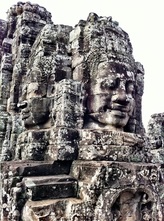
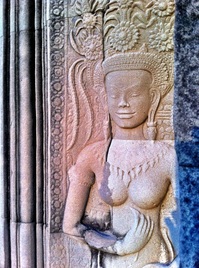
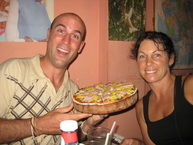
 Bayon Temple Next we flew into Siem Reap, a former small town made bustling by the grandeur of the ancient Khmer ruins that lie outside of it. The Angkor complex, consisting of Angkor Wat, Angkor Thom, and many other temple mountains and barays (man-made ponds) is one of the pinnacles of religious architecture in the world. Built between 900-1300 AD, each temple was painstakingly constructed to be either a microcosm of the Hindu universe or a Buddhist shrine (the Khmer empire alternated between Hinduism and Buddhism over its 700 year history). We started our exploration at sunrise, as the light broke over the silhouette of Angkor Wat in a dramatic show of beauty (see pic below). The level of detail present in the temples is staggering – intricately carved asparas (angels) sit alongside bass reliefs depicting great battles and the beginning of the universe. In some temples every square inch of sandstone is covered in intricate decoration. In others, the devarajas (God-king) who constructed the temples had his face prominently displayed in “face-towers” throughout the temple.  An Aspara (angel) in the sun Neda and I spent two days touring the ruins and using a guidebook to hunt for interesting details of the various temples we visited. Seeing the remarkable attention to detail that the builders put into each building reminded us how important of a tool attention can be. When we really choose to focus our attention, be it on our breath or of the feel of our sits bones on the chair we are sitting on, it brings us back to this present moment and the effect can be transformative. One would think that use of attention in this way might make us tired or worn out, but strangely enough the more you use focused attention, the more of it you receive. Neda has recently commented that after spending an hour or so focusing on her fruit carving, she feels more grounded and focused than before she started. For us, the Khmer art was inspiring as a source of this focused attention and its ability to create beauty that reverberates through time.  Cat and Jeff with Happy Pizza We enjoyed our time in Siem Reap as well, though perhaps not for focused attention :). Some friends we met during the Gibbon Experience also came to Siem Reap and we hung out together in the evenings, culminating on Friday night (4/20) in our sampling of the famous “Happy Pizza,” whose title did not disappoint! Next, we stopped at the capital of Cambodia, Phonm Phen, to find busy and bustling streets with lots of traffic and honking. We spent our one day there honoring our niece Allie’s memory at Wat Phnom with pink lotuses, rambutan offerings, and meditation at the temple. Today, we traveled even more south and circled back to the Gulf of Thailand from the Cambodia border this time. We will be spending the next week in a small fishing village called Kampot, relaxing and exploring the countryside of Cambodia before heading to Vietnam. See the amazing pics of Angkor (categorized by temple) as well as our time in Siem Reap here: http://flic.kr/s/aHsjzyojvi. See the shots of our time in Phonm Phen (Royal Palace, Riverfront, Wat Phnom) here: http://flic.kr/s/aHsjz39hHm
0 Comments
Arguably the most important concept in all of Buddhism is that of the 3 jewels - Buddha, Dharma, and Sangha. Each one embodies a different aspect of spiritual life. The Buddha represents the idea that a human can fully awaken to life in this moment. The Dharma is the teachings that help facilitate this awakening and the Sangha is the community that supports each other in their efforts. Often the sangha is more narrowly viewed as the people you practice with (i.e. the members of your temple), but in actuality it can be viewed as the whole community of man. 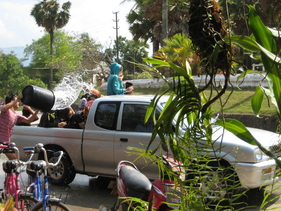 No holds barred water fight Our time in Laos has reaffirmed our faith in this community, as we have never been more openly accepted into a culture than we have here. It started with our invitation to Dett’s village for the housewarming party and ceremonies (see previous post), but that was just the beginning. After two days on a slow boat down the Mekong River, we arrived in Luang Prabang, the capital of ancient Laos, where the whole country gathers to celebrate Lao New Year (Bi Mai Lao). A seasonal water celebration held prior to the rainy season, it originally focused on the ceremonial bathing of the Buddha, cleaning of one’s household, and the giving and receiving of blessings to one’s neighbors. It has since evolved into a week-long water fight on the streets where little kids and young adults pour buckets of water onto passersby while dancing and playing. Those old enough, drink copious amounts of Beerlao and jump into pick-up trucks with their friends, traveling through the streets, singing, playing makeshift drums and cymbals, and spraying water (sometimes colored bright red or blue) and cornstartch through the air. 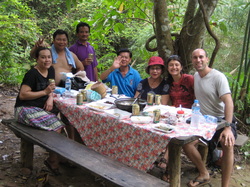 Impromptu Picnic Our first day here was New Year’s Eve and we spent the day visiting the beautiful Kuang Si Waterfalls, a multi-tiered natural beauty with azure teal swimming holes lying along its path. The waterfalls are also home to a Bear Rescue Center, a home for Asiatic and Malayan Sun Bears who have been rescued from poachers or Chinese bile extracting factories (read more about that by clicking link above and see a video of the bears playing by clicking here). As we walked amidst the falls, we noticed many Lao families sitting enjoying picnics as the swarms of tourists snapped photos. We wandered across a small footbridge for a photo and saw a family sitting around a table, beckoning us with their hands to join them. Unsure of what was happening, we tentatively walked over to the table only to be given a couple of cold cans of Beerlao and an invitation to sit. When they found out that we had learned a bit about Lao language, culture, and food, things really opened up as they encouraged us to sample delicious local delicacies like bamboo shoot stew, stir fried Mekong Riverweed, and fried pork bits with sticky rice and home-made chili sauce or “jaew mak pet”. What amazed us the most was that even with many tourists walking around the falls, this family didn’t just discount all of us as foreigners, but actually made an effort to connect. 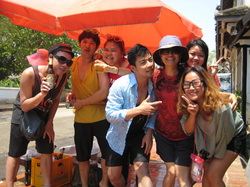 New Friends in Laos! Returning to the city, college age Lao kids were dancing on the street and drinking beers. We wished them a happy new year in their language, and were quickly offered a communal glass of beer along with a bucketful of water down our shirts! The last several days have been full of such experiences. Whether it be joining an impromptu Lao dance party or being invited to sit and try different local foods, we have felt overwhelmed by generosity and hospitality. It has made us realize how life in more developed countries may make us more guarded and less prone to such open sharing, especially with total strangers with which you can barely speak, like our Lao friends were doing. 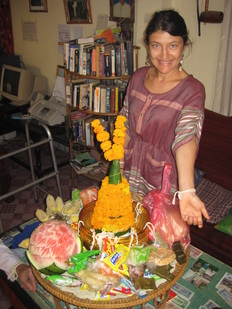 Neda's watermelon and blessing bracelet With this insight, came inspiration. How can we create community wherever we travel in the world, be it in faraway lands or in our own backyard? How can we foster a spirit of inclusiveness that breeds generosity and love instead of isolation and self-focus? We decided that one avenue was to simply start being more generous. In this spirit, Neda carved a watermelon which we presented to the family who runs our guesthouse here as a New Year’s gift. We then found ourselves invited to participate in their Baci ceremony, where we exchange blessings and bracelets with their 93 year old grandfather. For that moment in time, a brief community had been formed where we connected past culture and language. We became a part of that family’s sangha. We believe there are opportunities in our daily life to constantly be creating community in this way, even if it is just for a fleeting moment. For the Buddha, the sangha eventually came to mean the whole community of man. Leaving Laos we feel we have better understanding of what sangha means and a renewed vigor to create it wherever we go. What can you do today to connect with someone you might otherwise not – to create community where before there was none? To see our wonderful pictures of the New Year’s Celebration here in Laos, click here: http://flic.kr/s/aHsjzuYKKt
“But Neda, what about our plans to head to Luang Namtha and then Nong Khiaw for the riverboat journey on the Ou River? If we head back to Houay Xai with Dett we’ll be totally backtracking…" “Well, Dett said we could stay at his place, eat with his family – see real Lao life! So f&*! it, let’s do it!” 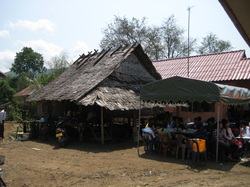 The village As travelers we all crave “authentic experiences.” We’ll pay big bucks to hike out to a remote hill tribe village to see how real hill tribe people live. But the problem of course is that if enough people do that, the village slowly changes to cater only to tourists – losing the authenticity that people wanted to come for in the first place. Neda and I have avoided such excursions in our belief that you can’t pay for an authentic experience – you have to let it come to you. When Dett invited us to come stay with him we realized that this was our chance and that we needed to be flexible enough in mind to let go of our “plans” and let things unfold as they may. 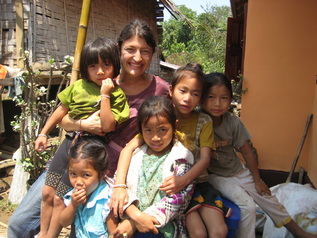 The little munchkins And boy did they unfold! We motorbiked about 30 km to Dett’s village where Dett suddenly veered off the road and brought us through a dirt track to his house. Dett’s village is all ethnically Khamu – their language is a Mon-Khmer language totally different from Lao. Many of the kids didn’t speak any Lao because they learn it later in school. As we unpacked from the bike Dett went to tell the town elder that he had invited foreigners into the village (luckily we were approved) as we stood around being smiled at (and stared at) by what seemed to be the whole town! The little girls of the village took an immediate affinity to Neda, who they kept calling “swuay mak” (very, very beautiful in Thai learned from Thai TV shows). Their endless giggling held the innocence of a time seemingly lost in more developed parts of the world. 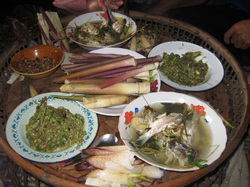 Traditional Lao meal For dinner and breakfast we ate communally with Dett, his family and friends. This involves sitting on the floor around several plates and bowls of food. Every two people get some glutinous sticky rice to share between them. You roll the sticky rice into a ball and dip it in the sauces or eat it with a piece of meat. The traditional food was amazing: boiled bamboo and forest ginger that you peel before dipping into a dip of hand roasted and smashed chilies along with local herbs and sugar. We also had roasted green eggplant smashed with chilies and herbs – like a Lao Baba Ganoush! They even had an herb they added to their fish soup that took away all the fishiness and left a delicious tasting stock! Perhaps even more interesting than the food was the style of drinking. In Khamu culture, there are only one or two glasses even with a group of 10 in the circle. When a person finishes drinking their glass of BeerLao, it is filled up and passed to the next person. So as you eat together you don’t have your own glass or your own plate. Dett said that this keeps their community strong as they share everything together. After breakfast, we put on our ceremonial clothes (“sorry Dett, we only have jeans and a few shirts to our name right now!”) and prepared for the coming festivities. In Khamu culture, the building of a new house in the village is an event of near equivalence to a marriage. Invitations are sent out and hundreds are invited. The family and friends set up tables, a sound system (which was hauled in on a tractor), and lots of food and drink for the coming guests. Right before we headed to the party, some of our friends from the Gibbon Experience arrived via taxi to join in. Dett had invited them before leaving the day before and they couldn’t resist joining. They even changed their plane tickets to make it work! 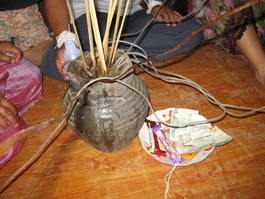 Sticky rice wine jar and well wishes dish The party was a fantastic time. It started with lunch and lots of Lao people offering us shots of lao-lao, a fiery moonshine distilled from sticky rice. Little did I know that one is supposed to take a sip to be polite before dumping the remainder on the ground. Oh well…After the lao-lao and some sort of fruit whisky, we were ushered into the house to offer blessings to the mother and father who own the house. Everyone put some small amount of money or candy onto a bowl and then knelt down together. You then tie a bracelet made of many white cotton strings to the homeowner’s wrist as you wish them well. They then tie a bracelet to your wrist to return the wishes. To complete the connection, they bring out a giant stone jar of fermented rice wine with numerous winding straws protruding from it. Everyone drinks together from the jar until it runs dry. After the blessing, a little band struck up inside the house with symbols and drums for the sword ceremony. In this ceremony, an elder Lao man wields two bamboo swords in an intricate dance that is meant to warn evil spirits to stay away from the home and the family who lives there. We were able to record a short video of the dance - http://flic.kr/p/bxF8W9. As we sat watching this glimpse of culture, I was overwhelmed at what I was experiencing and so grateful to have been included. As if that wasn’t enough, we all went outside and were taught to dance in the traditional Lao style (which involves a lot of wrist rotation). A local woman approached me and asked me to dance and we all got out there and had a great time. Luckily, we had been given some lessons in Lao style dance by the little girls earlier in the morning so it wasn’t too hard to pick up! Jeff captured the dance on video, see it here - http://flic.kr/p/bLhLTZ. 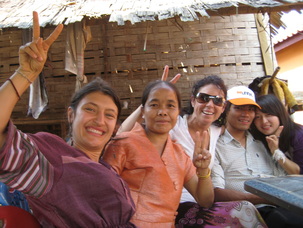 Cat, Toun & girlfriend and a guest Dancing, revelry, and a bit of Karaoke ensued. We sat at many different tables with people from all over the village, communicating with broken Lao and hand gestures. And it was wonderful. To be accepted at such a deep level despite our many differences is a fundamentally human thing to do. Our cultures couldn’t be more different in many regards, but the ability of human beings to form community and share joy together gives me hope when I am cynical about how alienated we have become from each other. Authentic experiences can be hard to find and it can be tempting to pay in order to try to get them. But like all good things, patience, flexibility, and a willingness to participate wholeheartedly will usually lead to things unfolding just as they need to.
To see all the fun pictures from the party, you can click here - http://flic.kr/s/aHsjyTBVQG. 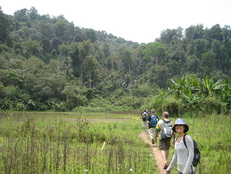 The Gibbon Experience is located about 3 hours north of Houay Xai in the remote Bokeo Nature Reserve in Laos. Our guide told us that the reserve has essentially been created by the money that the Gibbon Experience has brought into the area, saving about 300,000 acres of land from logging and poaching. Despite all this, only about 30 gibbons (5 families) still remain in the reserve, having been hunted by locals prior to the reserve being established. Our journey started in the back of a pick-up truck, crossing streams and heavy jungle on a dirt track road. At the end of the road was a simple village where we unloaded and hiked about an hour and a half into the jungle. The Gibbon Experience consists of 7 treehouses strung together by thousands of meters of zipline. To reach our treehouse, we stepped into our harness and jumped out over the jungle – flying at about 20-30mph over the canopy below. The sweeping views of the surrounding mountains were enough to take your breath away – that is if the 300 meters of ziplining hadn’t done that already! Check out the first video Jeff took while zipping - http://flic.kr/p/bxsJAQ. The jungle is so beautiful and almost hard to gather all of it in the horizon! 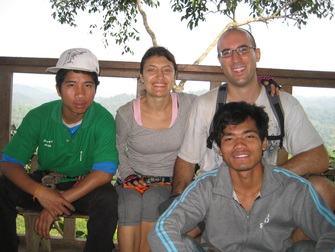 Dett and Toun at treehouse 5 The evening found us sharing a circular tree house with 6 other travelers (from Canada, New Zealand, England, and Denmark). The treehouse loomed out over a valley about a hundred feet above the jungle floor. It was complete with running water (including a shower with a spectacular view), solar electricity, and a cool box stocked with beers. Our guides Toun and Dett would bring dinner over from the ground based kitchen and our evenings consisted of watching the sunset, playing cards, and sharing traveling stories. Toun and Dett normally work building the treehouses, but due to some guides being away, we were incredibly lucky to have them lead our group. They are auto-didactic, having taught themselves English just by being at the Gibbon Experience – the only guides in the whole program that do speak English! After a stormy night that left us wondering how stable the treehouse was, dawn started to crack above the mountains and the magic happened. Echoing calls floated over the tree tops as the Gibbons began their morning singing ritual. We rose from our beds and gazed out at the tallest tree on the horizon and there they were! Their song to the newly awakened day was almost like a police siren as they swung dexterously from limb to limb. Eventually, they made their way to other trees and we caught sight of the female Gibbon – with a beautiful gold hue to her fur (the males are all black). Watching these wild creatures as we shared the tree tops with them gave us an immense feeling of spaciousness and connection. If you want to hear the gibbons’ calls, check out this video we recorded - http://flic.kr/p/bxsJB5. For the Gibbons the jungle is their playground and they need that open space to be wild and authentic. For us, the jungle was a practice in “reducing our filter” – living closer to the moment as it unfolds rather than being stuck in our heads with the past and present. Ziplining, with its beauty and adrenaline, brought us into the moment as did observing the Gibbons. The jungle itself with its endless assortment of sights, sounds, and smells is always inviting us to tune into what’s happening now. In those moments of connection, where we do find the space to really fly free, it was apparent to me how essential that experience is to staying sane. 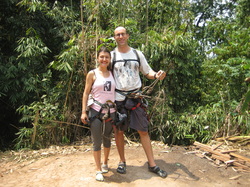 After 2 days of zipping around the jungle, we hiked back out and expected to continue to Luang Namtha in Northern Laos. But as we were walking Dett said, “you know if you have time, Toun’s girlfriend and her family are having a big house warming party in my village tomorrow and we’d love you to come stay with us.” Neda and I looked at each other, smiled, and prepared for the next crazy turn in this journey…to be continued in our next post! For pictures and all the fun videos we took ziplining, check out our flickr page - http://flic.kr/s/aHsjzrPyvv.
After leaving Chiang Mai, we headed further North to the city of Chiang Rai. Situated close to the “Golden Triangle” (where the border of Laos, Myanmar, and Thailand meet), this region became infamous for its sprawling opium fields in the 1960’s-1980’s. Now most of the opium has been replaced by other legal cash crops (tea, coffee, corn, etc…), but tourists still come to tour the area, which is rich in natural beauty. 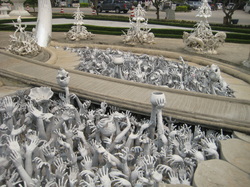 The Suffering Masses Having only a short time, we opted to explore the artistic and sacred side of Chiang Rai – represented by two opposing colors: Black and White. Our first stop was the White Temple (Wat Rong Khun), a recent architectural achievement by artist Chalermchai Kositpipat. Kositpipat veered away from the traditional gold coloring of Thai temples because he thought white better represented the purity of the enlightened state than the mercantile color of gold. The outside of the temple is a magnificent sight to behold – glittering white in the light, its sharp lines bringing an immediate feeling of awe. It almost oddly resembles a winter wonderland that somehow found itself in steamy Thailand. The entryway to the temple portrays humans and demons reaching up out of a pit of suffering – a symbol the artist says represents the suffering all beings must go through before reaching enlightenment. After passing over a bridge guarded by two giant demons, visitors enter the temple where a large white marble Buddha sits. On the wall in front of the Buddha are scenes of demons feeding on human suffering – missiles, whisky, pollution, etc… while on the walls on the side and behind the Buddha faithful practitioners are portrayed moving towards the heavenly realms. Perhaps most oddly, on the “demon wall”, there is a variety of science fiction and pop-culture icons moving around the demons. We saw Keanu Reeves from the matrix, the Hulk, Spiderman, the Predator, Darth Vader, even an Angry Bird from the iPhone game! Needless to say, the artist seemed to get a little carried away at this point as we struggled to understand what we were seeing and how it related to the overall message. 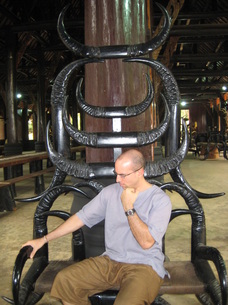 Jeff doing his best Conan impersonation The White Temple was about 13 kilometers south of town and after visiting, we headed about 25 kilometers north to the grounds of the Black Temple (Baan Si Dum). We found it to be opposite not just in color, but in style as well. Baan Si Dum is a complex of many buildings sharing the theme of artist Thawan Duchanee. It is dominated by a large Black Temple, filled with animal skins laid on long wooden tables and black chairs with buffalo horns at the top. There are also intricate wooden carvings depicting demons struggling with each other on the doorways. The rest of the grounds is littered with buildings that the artists didn’t have open that day. But walking among we saw common themes – animal bones (shark jaws, monkey skulls, etc…) and furs laid out domestically with bone carved furniture and Buddhist iconography. It was almost like a vision of a barbaric jungle king’s palace after he had converted to Buddhism. After the “bling” of the white temple, the Black Temple’s eerie scenes seemed to call the visitor towards the contemplation of death and the ephemeral aspect of our existence. Some writers have described these temples as representing the heaven and hell of Buddhism. Neda and I couldn’t help but chuckle as we read that description. How ironic that these two temples have come to represent as stark a dualism as heaven and hell. In actuality, Buddhism is all about moving beyond the idea of dualism to find the interconnected whole. Heaven and hell, in this regard, are two sides of the same coin. We can be in paradise with our self-focused thoughts and find pain and alienation or we can be in hell with a right understanding of our interconnectedness and find peace and repose. Perhaps thinking of the black and white temples as two separate pieces is the problem in the first place. If we go beyond their differences and find the common message of impermanence and surrender that they implore, we find a deeper meaning than either piece has on its own. We left Chiang Rai this morning, drove 3 hours and crossed the border into Laos. Our next stop is the Bokeo Nature Reserve where we will zipline hundreds of meters above the jungle floor in search of the elusive Black Gibbon! In the meantime, see the rest of Chiang Rai and the two temples here: http://flic.kr/s/aHsjyNTZGh |